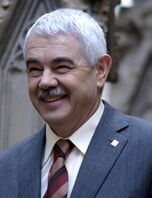Paqueonia: Difference between revisions
Philimania (talk | contribs) mNo edit summary |
Philimania (talk | contribs) |
||
| Line 145: | Line 145: | ||
== Politics == | == Politics == | ||
' | === Government === | ||
{{multiple image | |||
|align = right | |||
|total_width = 300 | |||
|image1 = Gerado.jpg|100px | |||
|caption1 = [[Monarch of Paqueonia|Monarch]] [[Gerado II]] | |||
|image2 = Patxi López 2011 (cropped).jpg|100px | |||
|caption2 = [[Crown Prince of Paqueonia|Crown Prince]] [[Fidel-Osvaldo]] | |||
}} | |||
Paqueonia is a {{wp|unitary}} {{wp|absolute monarchy}}, with a hereditary monarch. The head of state is the [[Monarch of Paqueonia|monarch]], currently King [[Gerado II]], who ascended to the throne in 1963 after the death of his father King [[Carlos V]] in 1963 and a period of regency. According to the country's constitution, the king is a symbol of unity and the eternity of the Paqueon Kingdom. The heir to the throne, also known as the [[Crown Prince of Paqueonia|Crown Prince]] acts as a secondary leader of Paqueonia. The current Crown Prince is [[Fidel-Osvaldo]], the son of Gerado who aquired his position in 1983 at the age of 18. | |||
The king also appoints the [[Chief Justice of Paqueonia|Chief Justice]] from the legislature and also appoints a minority of legislators to the [[National Council of Paqueonia]] with help from an advisory council. The king is allowed by the constitution to appoint some members to the National Council to represent special interests. These special interests are citizens who might have been electoral candidates who were not elected, or might not have stood as candidates. This is done to balance views in the National Council. Special interests could be people of particular gender or race, people of disability, the business community, civic society, and scholars. | |||
The {{wp|unicameral}} National Council, consists of 60 seats; 50 members are elected by {{wp|popular vote}} while 10 are appointed by the monarch, all of which serve five-year terms. The elections are held every five years after. The [[1997 Paqueon general election|last elections]] were held on the 10 Pulungana 1997. The balloting is done in a {{wp|non-partisan}} manner. All election procedures are overseen by the Elections and Boundaries Commission. | |||
=== Foreign relations === | === Foreign relations === | ||
Revision as of 04:49, 12 July 2022
This article is a work in progress. Any information here may not be final as changes are often made to make way for improvements or expansion of lore-wise information about Gentu. Please comment on this article's talk page to share your input, comments and questions. Note: To contribute to this article, contact User:Philimania. |
Kingdom of Paqueonia Reino de Paqueañes (Hestandan) | |||||||
|---|---|---|---|---|---|---|---|
Anthem: X Royal anthem: X | |||||||
 Location of Paqueonia (Green) in Oranland (Dark Grey) | |||||||
| Capital | Castelano | ||||||
| Largest city | Hidalgo | ||||||
| Official languages | Hestandan | ||||||
| Ethnic groups (2000) | 89.6% Hestando 8.9% Cavalan 1.5% Others | ||||||
| Religion (1999) | 47.5% Hafan 41.8% Terranity 5.2% No religion 5.5 Others | ||||||
| Demonym(s) | Paqueon | ||||||
| Government | Unitary absolute monarchy | ||||||
• Monarch | Gerado II | ||||||
| Fidel-Osvaldo | |||||||
| Carlos Avena | |||||||
| Legislature | National Council | ||||||
| Formation | |||||||
| 7 Phupu 1059–24 Okjatab 1092 | |||||||
| 14 Marto 1355 | |||||||
| 1 Enero 1543 | |||||||
| 30 Tebax 1945 | |||||||
| Area | |||||||
• Total | 616,777 km2 (238,139 sq mi) (X) | ||||||
• Water (%) | 0.52 | ||||||
| Population | |||||||
• 2000 census | |||||||
• Density | 94.8/km2 (245.5/sq mi) (X) | ||||||
| GDP (PPP) | 1999 estimate | ||||||
• Total | |||||||
• Per capita | |||||||
| GDP (nominal) | 1999 estimate | ||||||
• Total | |||||||
• Per capita | |||||||
| Gini (2000) | low · X | ||||||
| HDI (1998) | very high · X | ||||||
| Currency | Paqueon Karat (₭) (PAK) | ||||||
| Time zone | MTS-9 (West Oranland Time) | ||||||
| Date format | yyyy-mm-dd CE | ||||||
| Driving side | right | ||||||
| Calling code | X | ||||||
| Internet TLD | .pa | ||||||
| |||||||
Paqueonia (Hestandan: Paqueañes) or the Kingdom of Paqueonia, is a country in southwestern Oranland with overseas territories in the Domicas and the North Nullaric Ocean. The country is bordered by Cavala in the north, Paloa to the west, and the Zestoric Sea to the south and east.
With an area of 616,777 km2 (238,139 sq mi), Paqueonia is the X-largest country in Oranland and, with a stable population of 58.5 million, the X-most populous Oranish nation. Paqueonia's capital city is Castelano while the largest city is Hidalgo; other major urban areas include Duran, and X.
- History
Paqueonia is a developed country, a Unitary absolute monarchy, with King Gerado II as head of state. It is a high-income country and an advanced economy, with the world's X-largest economy by nominal GDP and the X-largest by PPP. Paqueonia has one of the shortest life expectancies in Oranland at 79.46 years as of 1998. It ranks particularly poorly in healthcare quality according to the Human Healthcare Index, with its healthcare system considered to be one of the most poorly funded worldwide. Paqueonia is a member of the Union of Realms (VR), the Oranland Trade Union (GF), the Oranland Space Organization (OSO), the Association of Hestandan States (AEH), the Alfred-Riverend Defence Organization (ARDO) among many other international organisations.
Paqueon art, music, literature and cuisine have been influential worldwide, particularly in the Domicas and Paqueon Aralona. As a reflection of its large cultural wealth, Paqueon has the world's X-largest number of GEKSO sites (X) and is the world's X-most visited country. Its cultural influence extends over X Hestandans, making the language the world's X-most spoken native language.
Etymology
TBA
History
Pre-Calidum

Archaeological research at X indicates the Hesterlon Peninsula was populated by early humans c. 1.5 million years ago. In X fossils have been found of the earliest known humans in Oranland, the Homo rectus. Modern humans first arrived in Hesterlon, from the east from modern day X on foot, about 60,000 years ago. The best known artefacts of these prehistorical human settlements are the famous paintings in the Ultima caves of X in northern Paqueonia, which were created from 60,000 to 20,000 BP by Early Oranish modern humans.
The largest groups inhabiting Paqueonia before Calidum colonisation were the Veragese people, or more specifically, the Aeroans, Amossans, and Norravans. The Amossans inhabited the southern portion of the region. The Aeorans inhabited much of the northern region as well as the Zestoric coast of the region, from the northwest to the southeast. Norravans occupied the interior of the region and adjacent areas.
Calidum and Pylosan colonies
TBA
Alarican rule
TBA
Early Middle Era
TBA
Paqueon Revolution
TBA
Colonial empire
TBA
Great War
TBA
Contemporary Age
TBA
Geography
TBA
Climate
TBA
Fauna and Flora
TBA
Politics
Government
Paqueonia is a unitary absolute monarchy, with a hereditary monarch. The head of state is the monarch, currently King Gerado II, who ascended to the throne in 1963 after the death of his father King Carlos V in 1963 and a period of regency. According to the country's constitution, the king is a symbol of unity and the eternity of the Paqueon Kingdom. The heir to the throne, also known as the Crown Prince acts as a secondary leader of Paqueonia. The current Crown Prince is Fidel-Osvaldo, the son of Gerado who aquired his position in 1983 at the age of 18.
The king also appoints the Chief Justice from the legislature and also appoints a minority of legislators to the National Council of Paqueonia with help from an advisory council. The king is allowed by the constitution to appoint some members to the National Council to represent special interests. These special interests are citizens who might have been electoral candidates who were not elected, or might not have stood as candidates. This is done to balance views in the National Council. Special interests could be people of particular gender or race, people of disability, the business community, civic society, and scholars.
The unicameral National Council, consists of 60 seats; 50 members are elected by popular vote while 10 are appointed by the monarch, all of which serve five-year terms. The elections are held every five years after. The last elections were held on the 10 Pulungana 1997. The balloting is done in a non-partisan manner. All election procedures are overseen by the Elections and Boundaries Commission.
Foreign relations
TBA
Military
TBA
Human rights
TBA
Administrative division
TBA
Economy
TBA
Aerospace industry
TBA
Agriculture
TBA
Tourism
TBA
Energy
TBA
Transport
TBA
Science and technology
TBA
Demographics
TBA
Major cities
TBA
Peoples
TBA
Languages
TBA
Education
TBA
Health
TBA
Religion
TBA
Culture
TBA
Gekso sites
TBA
Literature
TBA
Philosophy
TBA
Art
TBA
Cinema
TBA
Architecture
TBA
Music and dance
TBA
Cuisine
TBA
Sport
TBA
Holidays and festivals
TBA





